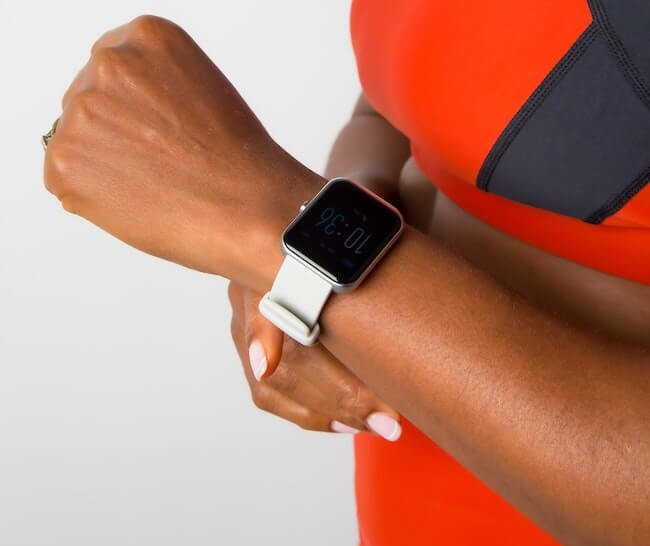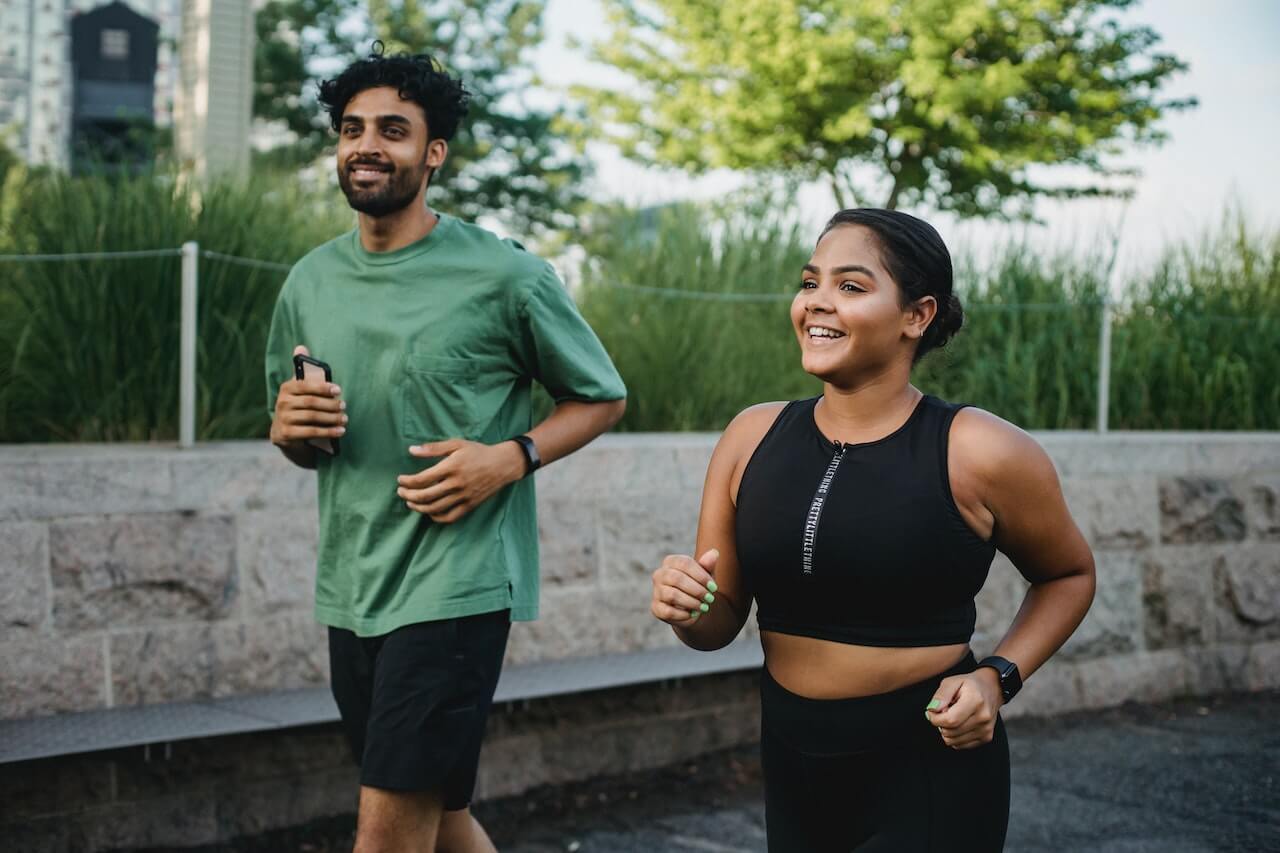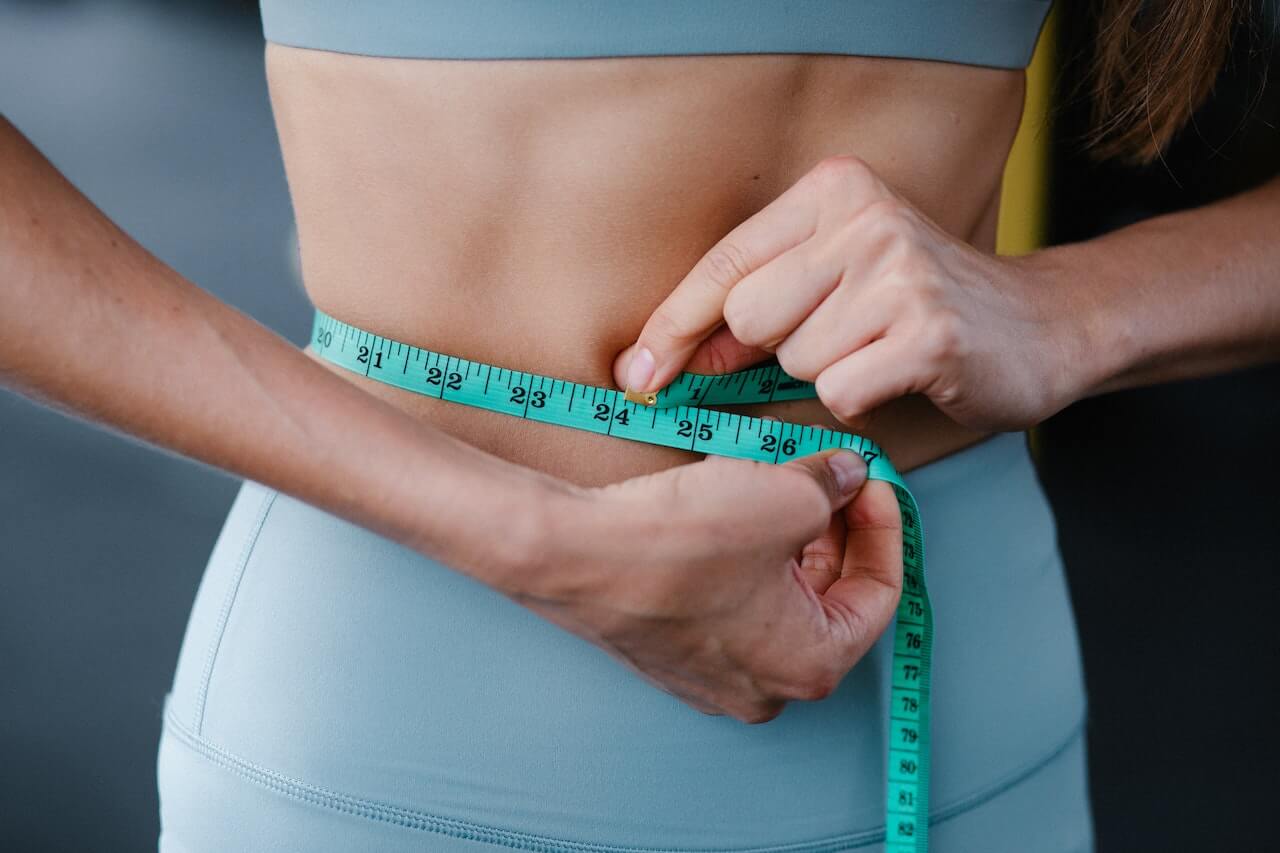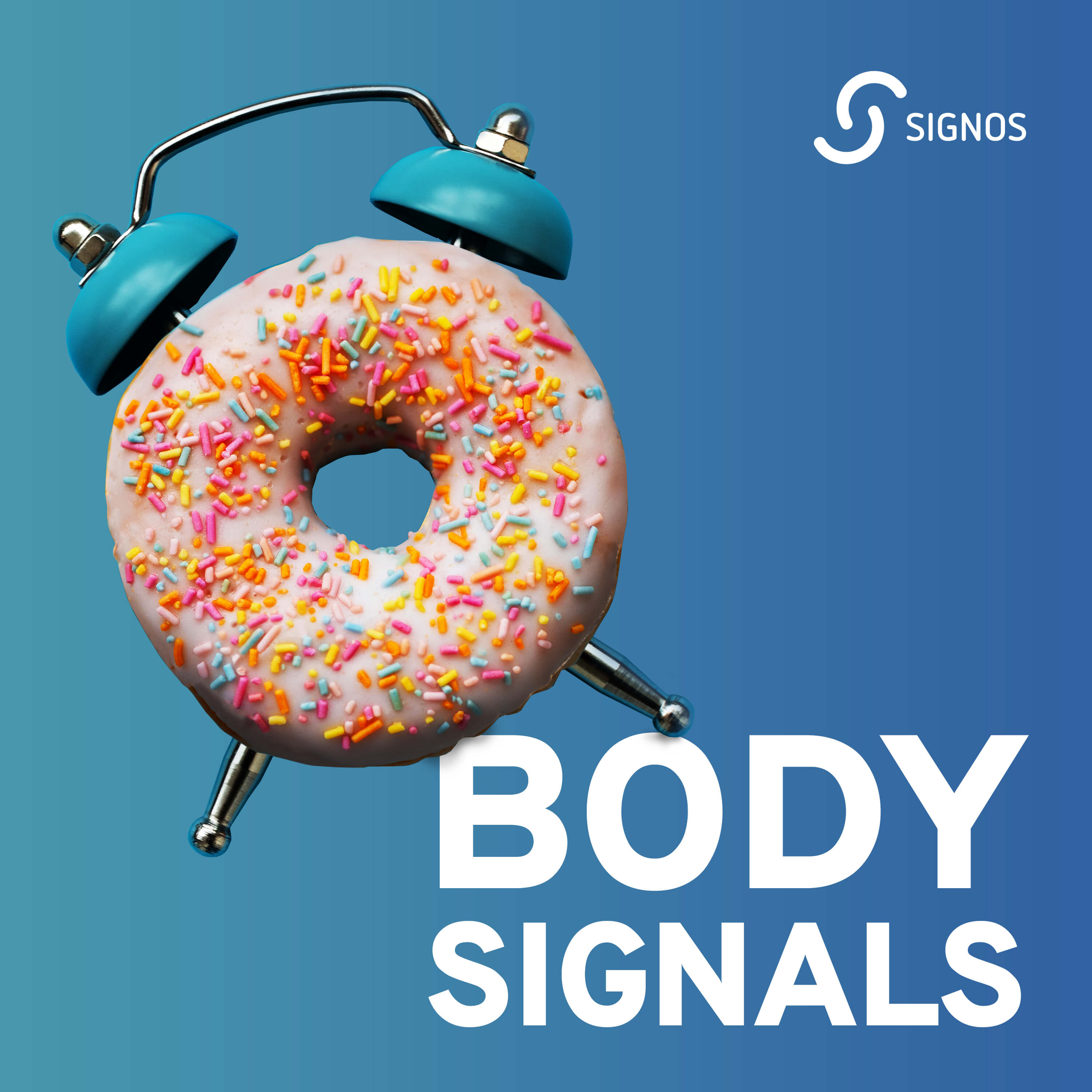Walking daily provides a multitude of potential health benefits.1 Walking is inexpensive, doesn’t require any equipment, and is accessible to most people.
But can you really lose weight by walking? Yes. A nutritious diet and brisk walking routine can lead to successful weight loss. In one study, a combination of a low-calorie diet and moderately strenuous exercise such as fast walking led to an 8% reduction in body weight over three to six months.3
However, if you reward yourself with a high-calorie snack after you finish your workout, you may be self-sabotaging. That may seem obvious, but researchers cite over-reporting exercise length and intensity and under-reporting food intake as the primary reasons people who walk for weight loss don’t make progress.2
Track your steps, fitness level, weight, and exercise time, and give yourself credit for progress in reaching your fitness and weight loss goals. Don’t just track the numbers on your scale.
Walking is a Good Form of Exercise for Weight Loss and Overall Health
Walking is a great low-impact exercise that almost anyone can do. It doesn’t require any specialized equipment or preparation. Adding 30 to 60 minutes of walking into your daily routine will help you burn calories and fat.4
While weight loss is many people’s primary goal for increasing exercise, walking has many other benefits that can help people live longer and healthier lives.
Moderate-intensity walking improves:5-9
- Cardiovascular fitness
- Insulin sensitivity
- Blood glucose control
- Blood pressure
- Mood
- Stress and anxiety
- Endurance
- Balance
- Bone and muscular strength
- Immune function
People who walked 10,000 steps every day for 12 weeks felt better, had more energy, a lower BMI, a smaller waist circumference, and lost weight, according to one study. 10 Walking tones your leg muscles and preserves muscle mass. Walking lowers stress and the amount of cortisol your body makes, which helps keep your blood sugar steady.
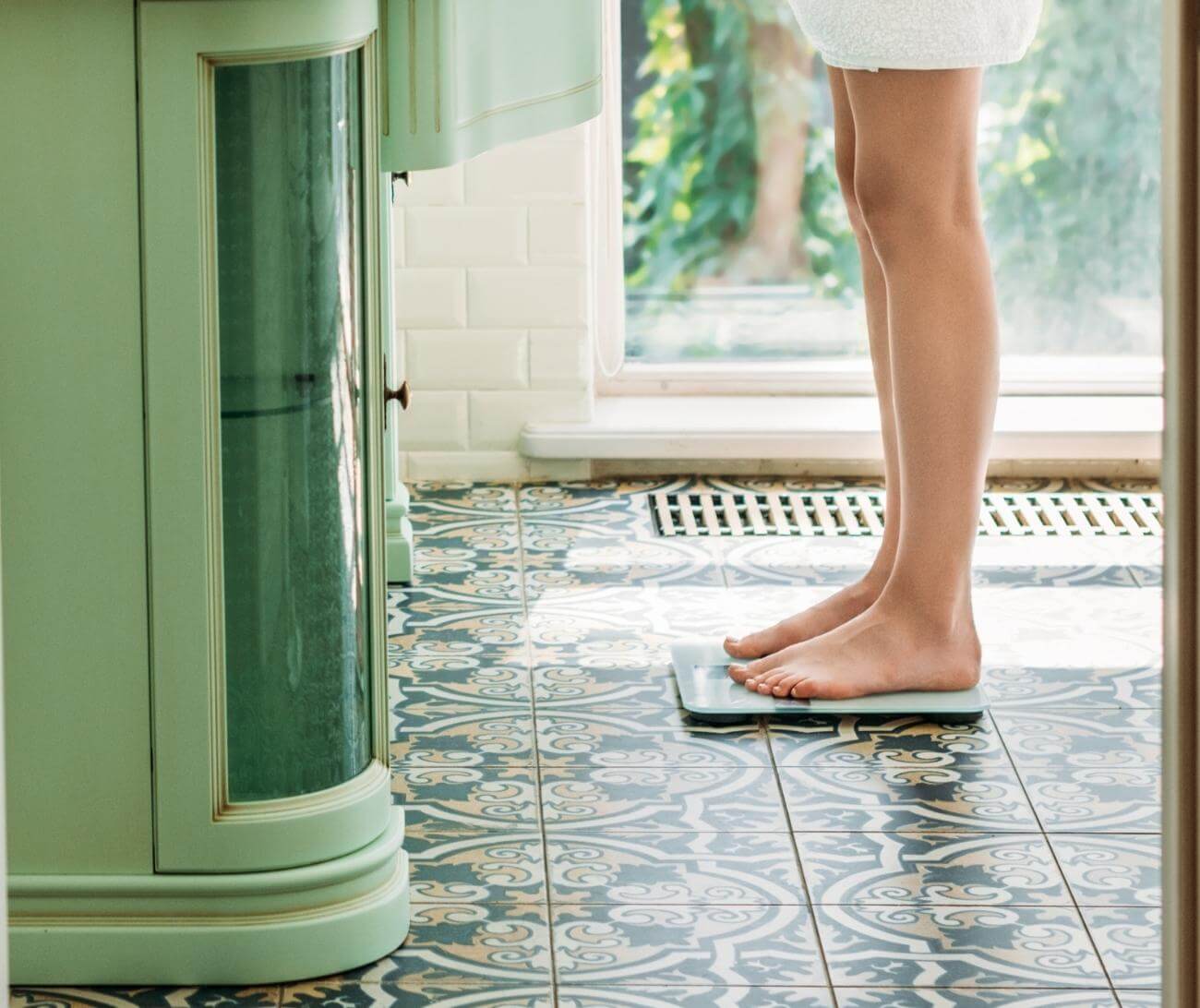
<p class="pro-tip"><strong>Learn more about </strong> <a href="/blog/metabolic-advantages-of-cardio">how walking and other forms of aerobic exercise can improve metabolic health</a>.</p>
How Much Should You Walk Per Day to Lose Weight?
For health and fitness benefits and to stabilize your weight, the Centers for Disease Control and Prevention (CDC) recommends choosing one of the following options:
- Walking at a moderate intensity for 30 minutes a day, five days a week, for a total of 150 minutes of exercise per week.
- Walking at a vigorous intensity for seventy-five minutes per week.
- Doing a combination of moderate and vigorous-intensity walking.
While walking of any type is great, walking at a higher intensity can be even more helpful, even as few as three 10-minute exercise bursts per day.11
According to the American College of Sports Medicine (ACSM), if you want to lose weight, increase your weekly walking to 200 to 300 minutes of exercise per week. They found that over a three-month period,12
- Less than 150 minutes of physical activity per week resulted in minimal weight loss.
- Between 150 minutes per week and 225 minutes per week resulted in a 4-to-6-pound weight loss.
- Between 225 minutes per week and 420 minutes per week resulted in an 11-to-16.5-pound weight loss.
While this sounds like a lot of exercise, 420 minutes per week is just one hour of walking each day!
Walking Can Help Increase Insulin Sensitivity
Sitting for long periods reduces insulin sensitivity. Exercise increases glucose uptake into cells and improves insulin sensitivity. 13 One study found that people who regularly walk fast have a lower risk of developing type 2 diabetes, a chronic disease that damages blood vessels and nerves throughout the body.14
Another small study found that women who had type 2 diabetes could achieve better insulin sensitivity just as well with low-intensity exercise as with high-intensity exercise.15 Exercise of any kind, even low-intensity walking, could improve insulin sensitivity.
How Walking Affects Glucose Spikes
Timing may also make a difference. A 15-minute walk after meals can help prevent glucose spikes. In this study, inactive adults aged 60 or older with a BMI of less than 35 kg/m2 and a fasting blood glucose concentration of between 105 and 125 walked for 15 minutes after meals or 45 minutes daily.
Walking for 15 minutes after a meal was much more effective at lowering blood sugar spikes 3 hours after dinner than a single longer walk. Post-meal walks were timed at 30 minutes after eating and were nearly moderate in intensity, suggesting that brief bouts of walking after meals are more important than exercise intensity for glycemic control. 16 Walking right after eating can also help to reduce snacking after or between meals.
In another small study, comparing people with type 2 diabetes who walked in the morning with those who walked later in the day, afternoon walkers saw the following benefits:17
- Better insulin sensitivity
- A decrease in body fat
- Lower fasting blood glucose
- An increase in exercise power
How Many Calories Are Burned While Walking?
Online calculators use the following factors to determine how many calories you burn while walking:
- Age
- Sex
- Height
- Weight
- Exercise intensity (METs)
- The duration of your exercise session
Your exercise intensity will be affected by whether you are walking on a flat surface or an incline, as well as how fast you are walking.
Body weight will also affect how many calories you burn. For example, a 180-pound person will burn approximately 100 calories per mile, while a 120-pound person will burn approximately 65 calories per mile.18
This formula can be used to estimate the number of calories you might burn per mile:
Calories burned=BMR x METs/24 x hour
BMR equations:
- Men: BMR = 88.362 + (13.397 x body weight in kilograms) + (4.799 x height in centimeters) – (5.677 x age in years)
- Women: BMR = 447.593 + (9.247 x weight in kilograms) + (3.098 x height in centimeters) – (4.330 x age in years)
METS:
- 2 mph = 2.5 METs
- 3 mph = 3.5 METs
- 3.5 mph = 4.0 METs
- 4.0 mph = 4.5 METs
- 4.5 mph = 5.0 METs
Calculated calorie burn per mile does not necessarily equal expected weight loss.
In a study comparing Amish men and women who have an agrarian lifestyle with the average American adult in 2003:
- Amish men walked an average of 18,000 steps per day.
- Amish women walked an average of 14,000 steps per day.
- The average American adult walks 5,000 steps per day.
The average American adult walks 13,000 fewer steps than the average Amish man and 9,000 fewer than the average Amish woman, which could explain a yearly weight gain of 68 pounds for men and 47 pounds for women.
This significant weight gain isn't seen because weight gain can't be explained by just how many calories you eat or how many calories you burn. Calories burned while walking or engaging in any other exercise do not directly translate into pounds lost.19,20
Walking to burn calories isn't the most time-efficient way to lose weight, but the calories you burn add up, and you can certainly boost them by changing your walking speed and incline.
How To Increase Calorie Burn From Walking
There are many ways to increase calorie burn while walking and make your exercise more efficient if your goal is to lose weight.
1. Increase Your Intensity When Walking
The faster you walk, the more calories you can burn. Power walking engages more muscles in your body, including your core, shoulders, and arms. A brisk walking pace varies with height but is typically between 3.0 mph and 4.5 mph. Walking at this pace should make you feel slightly breathless, but you should still be able to speak in complete sentences.
Running can increase calorie burn even more than faster walking.20 In one study, running at a marathon pace for an hour yielded just over twice the energy expenditure (calories burned) of walking at 3.0 mph for an hour.4 Another study showed that calorie expenditure is about 30% higher for running versus walking the same distance. 21
However, not everyone is able to run. Running is more taxing on your joints. Injuries are more common with running than walking because fatigue leads to poor running posture. Try short sprints or pick up your pace for a quick burst of more intense exercise to increase your calorie burn.
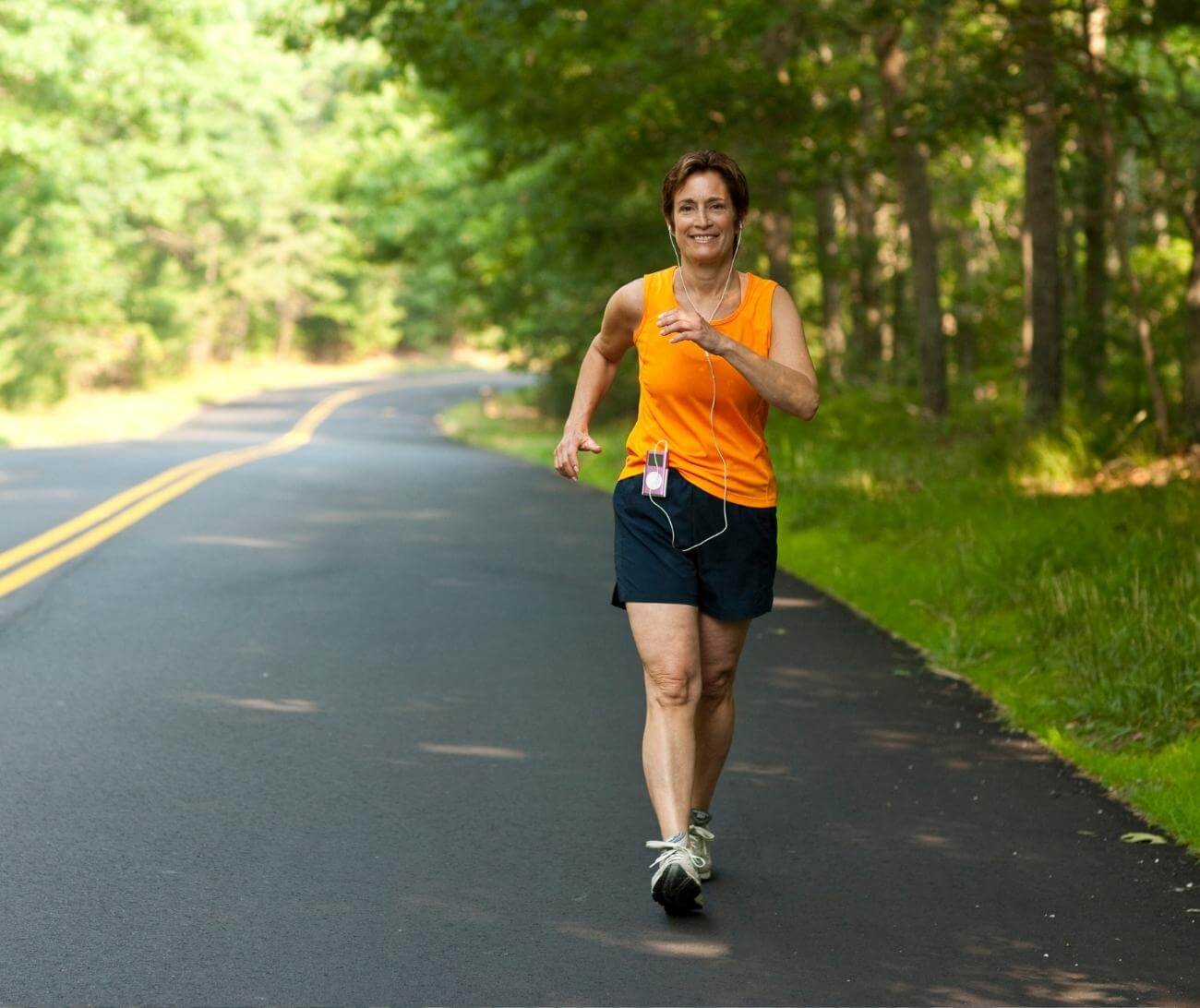
Besides checking whether you are breathless or able to talk in complete sentences, another way to gauge your walking intensity is to check your heart rate. Aim for a moderate intensity when you are walking. Calculating your target heart rate can help ensure you are in your fat-burning training zone.
Find your target heart rate by age and exercise intensity
- Low Intensity: 57%-63%
- Moderate Intensity: 64%-76%
- Vigorous Intensity: 77%-95%)
- Maximum Intensity: 96%-100%*
*100% = 220- your age
2. Add Intervals
High-intensity interval training (HIIT) is a great way to burn more calories, especially as you are building your endurance. In a study that compared single sessions of aerobic, resistance, and HIIT workouts, HIIT workouts burned 25% to 30% more calories than other types of exercise. 22 Most HIIT workouts have repeated episodes of intense workouts followed by a recovery period. To burn more calories while walking, do a few short bursts of more intense activity.
Changing your speed while walking also burns more calories. In one small study that compared constant-speed walking with oscillating-speed walking, walkers burned 6% to 20% more calories when varying their speed.23
3. Add Incline
Whether you walk outside or on a treadmill, add some incline. Choose hilly hikes when walking outdoors or increase the treadmill incline when indoors. The average 150-pound person will burn about 80 calories per mile while walking on flat ground but can burn 128 calories when walking on a 5% incline.
Be sure to maintain good posture on the treadmill. Keep your core aligned. Don’t bend at the waist and try not to hold on to the treadmill bar. Doing so allows the treadmill belt to do much of the work for you, significantly reducing calorie burn.
If you need to hold on to the treadmill bar, try slowing your speed until you adapt to the increased incline. It is better to walk at a slower speed and with smaller, quicker steps than to use longer strides while holding on to the sidebars. 18
4. Add Strength Training
Add resistance exercise to your walking program to maximize calorie burn.11 Strength training preserves muscle mass and increases muscle strength, so you can make more progress faster. The Centers for Disease Control and Prevention recommends muscle-strengthening exercises two or more days per week. It is important to strengthen both your upper and lower body muscles.
Resistance exercise is any exercise in which your muscles contract against external resistance. Some examples of resistance exercise:
- Lifting free weights
- Using your body weight for push-ups, squats, or sit-ups
- Using weight machines
- Using resistance bands
When you plan your exercise, try to include resistance exercise for every major muscle group. Energy expenditure may not be as high for resistance exercise as it is for endurance exercise, but increased muscle mass can increase 24-hour energy expenditure, making it a very effective part of your weight loss program.24
5. Add Walking Poles
Walking poles force you to use your upper body while walking, which increases calorie burn. To burn the most calories, Nordic walking uses special walking poles, a long stride, and a high speed that is kept up for longer periods.
In one study, traditional walking plus diet and Nordic walking plus diet were compared. After 3 months, Nordic walkers lost 5% of their body weight and traditional walkers lost 3%. After 6 months, Nordic walkers lost 6% of their body weight and traditional walkers lost 5%. The Nordic walking group had an 8% reduction in body fat and increased arm and shoulder strength.25
Using walking poles on a slightly hilly walk can increase calorie burn and upper and lower body muscle strength.
6. Wear a Weighted Vest
As you lose weight, you will start burning fewer calories while doing the same amount of exercise. Energy expenditure decreases with decreasing body mass.4 Examples of calorie reductions from performing the same level of exercise at a lower body weight include the following:19
- 170 to 250 kcal/day for a 10% weight loss
- 325 to 480 kcal/day for a 20% weight loss.
Add a weighted vest or a weighted backpack to compensate for those lost pounds and keep the calorie burn consistent. Keep the added weight close to your body core to prevent balance problems or injuries.
Wrist or ankle weights can throw you off balance and cause injury, and in one study, carrying hand weights did not result in increased calorie expenditure.26
In one small study, people wore weighted vests and walked slowly (2.5 miles per hour) at different inclines. Their results suggested a 15% of body weight weighted vest is ideal on flat terrain and a 10% of body weight weighted vest is recommended for inclines.27
How To Choose The Right Weight for a Walking Vest
To burn 3.56 kcal/min:
- Wear a vest that equals 15% of your bodyweight
- Grade / incline: 0% (flat)
To burn 4.93 kcal/min:
- Wear a vest that equals 10% of your bodyweight
- Grade / incline: 5%
To burn 6.9 kcal/min:
- Wear a vest between 10% of your bodyweight
- Grade / incline: 10%
To burn 8.7 kcal/min
- Wear a vest between 10% to 15% of your bodyweight
- Grade / incline: 15%
{{mid-cta}}
Burn More Calories Throughout Your Day
Non-exercise activity thermogenesis (NEAT) describes energy expenditure for all your daily activities that are not classified as exercise. Whether you fidget while working, pace while talking on the phone, or choose the stairs over an elevator, the calories you burn add up.
Getting up and walking throughout the day would not be described as exercise, but it can still lead to weight loss. More breaks to get up and move around can also improve glucose utilization, leading to better lipid levels and reduced body fat. 13
Treadmill vs. Walking Outdoors
Treadmills are great for indoor workouts on cold or rainy days, but the lack of air resistance results in a lower energy burn. You can compensate for that by using a 1% incline.28
Use your treadmill safely.
- Verify that small children or pets are clear of the area when the belt is in motion.
- Never step onto a moving belt.
- Clip the safety stop key to your clothing to stop the treadmill if you should fall.
- Take the safety key with you when you are done walking to prevent injury to others.
Use good posture when walking, whether your treadmill is flat or on an incline. Good posture includes the following:
- Holding your head up.
- Looking forward, not down.
- Keeping your shoulders back, not by your ears.
- Keeping your hips tucked, don’t bend at the waist or let your hips trail behind you.
- Engaging your abdominal and back muscles.
- Standing tall, as though someone was pulling you towards the ceiling.
- Maintaining a neutral posture without leaning forward or back.
- Using your arms to walk faster and burn more calories.
Unless you need to hold on for a medical condition, let go of the sidebars. Holding on reduces calorie burn and inhibits a natural walking gait.
How to Start a Walking Program
Most people find that they are most committed to the activities they plan and schedule. Here are a few things to consider as you plan your walking program:
1. Get medical clearance
Talk to your healthcare provider before starting any exercise, even a more intense walking program, to see if you have any medical restrictions.
2. Invest in good walking gear
- Choose comfortable socks that wick sweat away from your feet.
- Wear bright colors and reflective strips if you are walking near a street.
- Choose shoes that are flexible, well-fitting, and do not need to be “broken in.”
3. Set a schedule
Just like you schedule important meetings and events, you should also schedule time for your walk. Determine in advance how far you will walk, how fast, and how you will track your progress.
4. Get support
Tell friends and family about your walking plans and enlist volunteers to walk with you.
5. Check your technique
Record yourself walking on a treadmill or ask a friend to videotape you while you walk.
6. Invest in a fitness tracker
Use an activity tracker or app to track your activity throughout the day. Set step goals and walking time goals for the day. Check with your insurance company to see if you qualify for a discount if you track a certain number of steps each day.
7. Monitor your heart rate
To ensure that you are walking fast enough to burn fat, use your fitness tracker to monitor your heart rate.
8. Add entertainment
Whether you prefer a great playlist, an audiobook, or the company of a friend, reward yourself for walking by preparing your entertainment in advance.
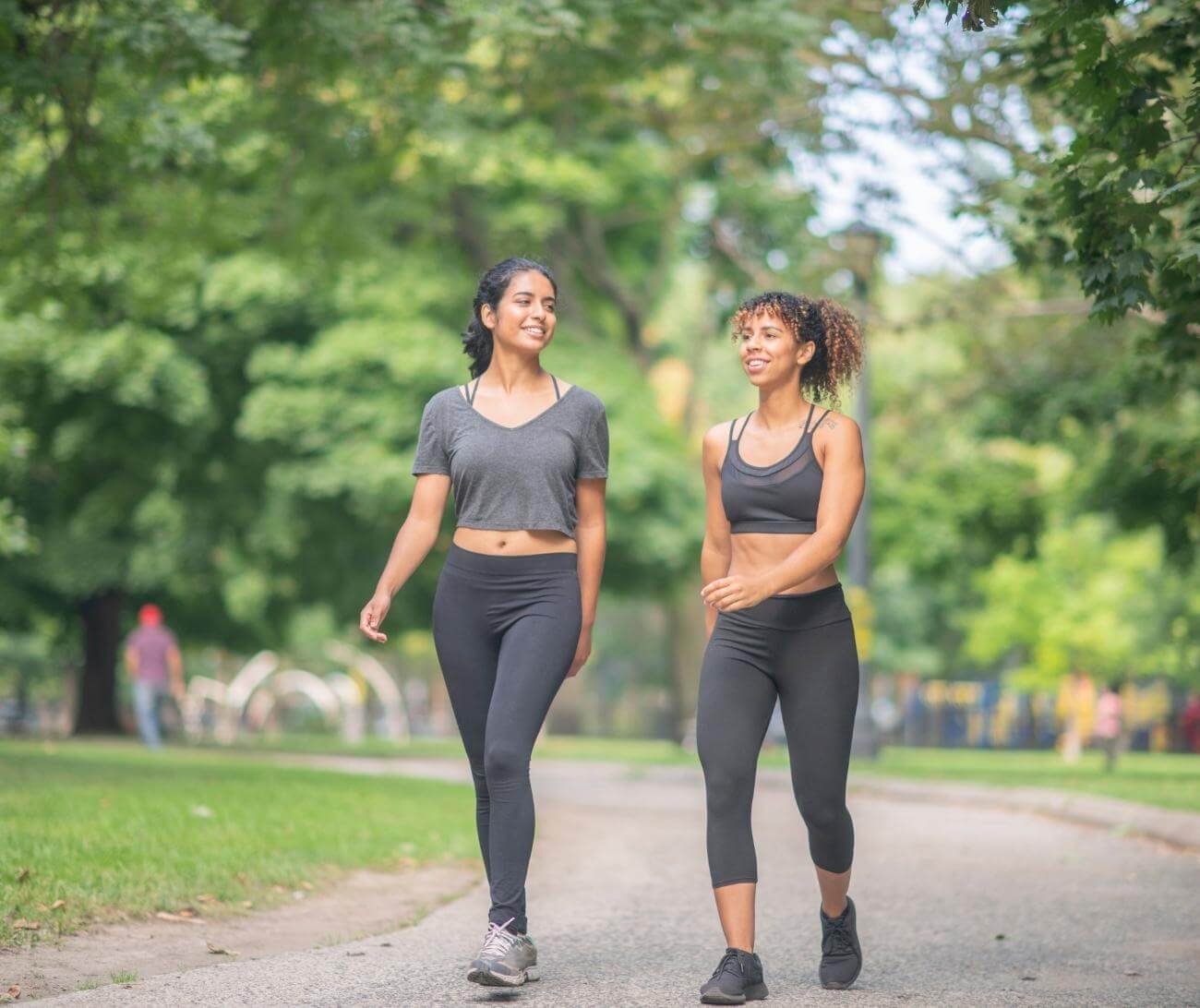
Learn more weight loss tips for beginners you can implement in your walking for weight loss program today.
Walking Has Many Health Benefits
Every time you choose to move, you are improving your health and burning calories. Walking reduces your risk for chronic diseases such as type 2 diabetes and obesity, improves your glucose sensitivity, reduces stress, and helps you manage your weight.
When you are done walking, rehydrate with water or green tea. In one small study, consuming green tea regularly after exercise increased fat burning.29 Consume a diet high in nutritious foods and avoid highly-palatable, processed foods full of excess calories that make you hungrier and less likely to keep walking for weight loss. A nutritious diet and daily walking can lead to a 20% greater weight loss than dieting alone and a 20% greater chance that you will sustain your weight loss.11
- Item 1
- Item 2
- item 3
Topics discussed in this article:
References
- Richardson CR, Newton TL, Abraham JJ, Sen A, Jimbo M, Swartz AM. (2008). A meta-analysis of pedometer-based walking interventions and weight loss. Ann Fam Med;6(1):69-77. doi:10.1370/afm.761
- Cox CE. Role of Physical Activity for Weight Loss and Weight Maintenance. (2017). Diabetes Spectrum;30(3):157-160. doi:10.2337/ds17-0013
- Kleist B, Wahrburg U, Stehle P, et al. (2017) Moderate Walking Enhances the Effects of an Energy-Restricted Diet on Fat Mass Loss and Serum Insulin in Overweight and Obese Adults in a 12-Week Randomized Controlled Trial. The Journal of Nutrition;147(10):1875-1884. doi:10.3945/jn.117.251744
- Loftin M, Waddell DE, Robinson JH, Owens SG. (2010) Comparison of Energy Expenditure to Walk or Run a Mile in Adult Normal Weight and Overweight Men and Women. The Journal of Strength & Conditioning Research;24(10):2794-2798. doi:10.1519/JSC.0b013e3181cc26cd
- Lee IM, Buchner DM. (2008) The Importance of Walking to Public Health. Medicine & Science in Sports & Exercise;40(7): S512-S518. doi:10.1249/MSS.0b013e31817c65d0
- Wilkin LD, Cheryl A, Haddock BL. (2012) Energy Expenditure Comparison Between Walking and Running in Average Fitness Individuals. The Journal of Strength & Conditioning Research;26(4):1039-1044. doi:10.1519/JSC.0b013e31822e592c
- Hong H-R, Jeong J-O, Kong J-Y, et al. (2014) Effect of walking exercise on abdominal fat, insulin resistance and serum cytokines in obese women. J Exerc Nutrition Biochem;18(3):277-285. doi:10.5717/jenb.2014.18.3.277
- Hanson S, Jones A. (2015) Is there evidence that walking groups have health benefits? A systematic review and meta-analysis. British Journal of Sports Medicine;49(11):710-715. doi:10.1136/bjsports-2014-094157
- Bartlett DB, Willis LH, Slentz CA, et al. (2018) Ten weeks of high-intensity interval walk training is associated with reduced disease activity and improved innate immune function in older adults with rheumatoid arthritis: a pilot study. Arthritis Research & Therapy;20(1):127. doi:10.1186/s13075-018-1624-x
- Yuenyongchaiwat K. (2016) Effects of 10,000 steps a day on physical and mental health in overweight participants in a community setting: a preliminary study. Braz J Phys Ther;20(4):367-373. doi:10.1590/bjpt-rbf.2014.0160
- Public Health England. (2017) 10 minutes brisk walking each day in mid-life for health benefits and towards achieving physical activity recommendations. https://assets.publishing.service.gov.uk/government/uploads/system/uploads/attachment_data/file/639030/Health_benefits_of_10_mins_brisk_walking_evidence_summary.pdf
- Donnelly JE, Blair SN, Jakcic JM, Manore MM, Rankin JW, Smith BK. (2009) Appropriate Physical Activity Intervention Strategies for Weight Loss and Prevention of Weight Regain for Adults. Medicine & Science in Sports & Exercise;41(2):459-471. doi:10.1249/MSS.0b013e3181949333
- Healy GN, Dunstan DW, Salmon J, et al. (2008) Breaks in Sedentary Time: Beneficial associations with metabolic risk. Diabetes Care;31(4):661-666. doi:10.2337/dc07-2046
- Iwasaki M, Kudo A, Asahi K, et al. (2021) Fast walking is a preventive factor against new-onset diabetes mellitus in a large cohort from a Japanese general population. Sci Rep;11(1):716-716. doi:10.1038/s41598-020-80572-y
- Braun B, Zimmermann MB, Kretchmer N. (1995) Effects of exercise intensity on insulin sensitivity in women with non-insulin-dependent diabetes mellitus. Journal of Applied Physiology;78(1):300-306. doi:10.1152/jappl.1995.78.1.300
- DiPietro L, Gribok A, Stevens MS, Hamm LF, Rumpler W. (2013) Three 15-min Bouts of Moderate Postmeal Walking Significantly Improves 24-h Glycemic Control in Older People at Risk for Impaired Glucose Tolerance. Diabetes Care;36(10):3262-3268. doi:10.2337/dc13-0084
- Mancilla R, Brouwers B, Schrauwen‐Hinderling VB, Hesselink MKC, Hoeks J, Schrauwen P. (2021) Exercise training elicits superior metabolic effects when performed in the afternoon compared to morning in metabolically compromised humans. Physiological Reports;8(24) doi:10.14814/phy2.14669
- Ainsworth BE, Haskell WL, Herrmann SD, et al. (2011) 2011 Compendium of Physical Activities: A Second Update of Codes and MET Values. Medicine & Science in Sports & Exercise;43(8):1575-1581. doi:10.1249/MSS.0b013e31821ece12
- Hill JO, Wyatt HR, Peters JC. (2012) Energy Balance and Obesity. Circulation;126(1):126-132. doi:doi:10.1161/CIRCULATIONAHA.111.087213
- Williams PT. (2013) Greater Weight Loss from Running than Walking during a 6.2-yr Prospective Follow-up. Medicine & Science in Sports & Exercise;45(4):706-713. doi:10.1249/MSS.0b013e31827b0d0a
- Hall C, Figueroa A, Fernhall B, Kanaley JA. (2004) Energy Expenditure of Walking and Running: Comparison with Prediction Equations. Medicine & Science in Sports & Exercise;36(12):2128-2134. doi:10.1249/01.Mss.0000147584.87788.0e
- Falcone PH, Tai CY, Carson LR, et al. (2015) Caloric expenditure of aerobic, resistance, or combined high-intensity interval training using a hydraulic resistance system in healthy men. J Strength Cond Res.;29(3):779-85. doi:10.1519/jsc.0000000000000661
- Seethapathi N, Srinivasan M. (2015)The metabolic cost of changing walking speeds is significant, implies lower optimal speeds for shorter distances, and increases daily energy estimates. Biology Letters;11(9):20150486. doi:10.1098/rsbl.2015.0486
- Clark JE. (2015) Diet, exercise or diet with exercise: comparing the effectiveness of treatment options for weight-loss and changes in fitness for adults (18–65 years old) who are overfat, or obese; systematic review and meta-analysis. Journal of Diabetes & Metabolic Disorders;14(1)doi:10.1186/s40200-015-0154-1
- Muollo V, Rossi AP, Milanese C, et al. (2019) The effects of exercise and diet program in overweight people - Nordic walking versus walking. Clin Interv Aging;14:1555-1565. doi:10.2147/CIA.S217570
- Campaña CT, Costa PB. (2017) Effects of walking with hand-held weights on energy expenditure and excess postexercise oxygen consumption. J Exerc Rehabil;13(6):641-646. doi:10.12965/jer.1735100.550
- Kravitz LM, J. (2013) The metabolic cost of slow graded treadmill walking with a weighted vest in untrained females. AzureedgeNet. https://acewebcontent.azureedge.net/certifiednews/images/article/pdfs/ACE%20Weighted%20Vest%20Study%20Complete%20Report.pdf
- Jones AM, Doust JH. (1996) A 1% treadmill grade most accurately reflects the energetic cost of outdoor running. Journal of Sports Sciences;14(4):321-327. doi:10.1080/02640419608727717
- Ota N, Soga S, Shimotoyodome A, et al. (2005) Effects of Combination of Regular Exercise and Tea Catechins Intake on Energy Expenditure in Humans. Journal of Health Science;51(2):233-236. doi:10.1248/jhs.51.233





